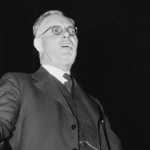Arvanitakis on American Politics: Voting in a time of a pandemic

It did not take long for the fragile peace between the Democratic and Republican that was brought on by coronavirus to breakdown. When member of both parties started taking the virus seriously, there was a pause in ‘politics as usual’.
The deep divisions once again became obvious when the first coronavirus ‘stimulus package’ was being debated in March. While these negotiations eventually reached a bipartisan position, just how little trust exists between the protagonists emerged.
Learning from the 2008 bailout package, Democrats wanted intense scrutiny and oversight of the proposed US$2 trillion package.
The Trump Administration made it clear, however, that such an oversight would stifle their ability for an agile response. Bruised and angered by the impeachment processes, the President was in no mood to have the Democrats looking over his shoulder.
Even the virus is partisan
While the stimulus package is one of the few things both the parties could agree on, since then everything about the virus has become partisan.
This partisan split does not only refer to whether the President is doing a good job but, even reflects just how seriously the threat should be taken. In March, an NBC News/Wall Street Journal poll revealed that 68 percent of Democrats were worried someone in their family could catch the virus compared to just 40 percent of Republicans.
Only this week, a new poll showed how partisanship has spoilt over religious freedoms. The poll by The University of Chicago Divinity School and The Associated Press-NORC Centre for Public Affairs Research found Republicans are more likely than Democrats to say prohibiting in-person services during the coronavirus outbreak violates religious freedom, 49 percent to 21 percent.
In fact, 58 percent of Democrats say in-person religious services should not be allowed at all during the pandemic, compared with 34% of Republicans who say the same.
This split is also reflected on how quickly restrictions should be eased and the economy should open. The Pew Research Centre poll released on 7 May found that 68 percent of Americans continue to say be concerned about coronavirus-related restrictions on public activity being lifted too quickly.
The poll found, however, that 87 percent of Democrats were concerned restrictions would be lifted too quickly, compared with only 47 percent of Republicans.
Pew point out that this gap is widening: a month earlier the split was 81 percent of Democrats and 51 percent of Republicans.
This has been aggravated by the President breaking with his own guidelines by backing conservative anti-quarantine protesters to ‘liberate’ their states from Democrat-led government established restrictions.
All this needs to be seen in context of the November presidential election. The pandemic has made everything uncertain including the act of voting.
Crisis and voting
The pandemic has seen primaries postponed (Ohio) and a spike in voting by mail – though the impact varies by state. In states such as Illinois, where there isn’t a tradition of voting by mail, turnout in primaries were much lower than in states such as Florida and Arizona which generally cast a large percentage of ballots by mail.
As FiveThirtyEight pointed out, this is not the first time that election cycles were impacted by crisis – and a presidential election has never been delayed. In fact, there was a presidential election during the Civil War in 1864 – which was second U.S. presidential election to take place during wartime (the first being was during the War of 1812).
During the 1918 Spanish flu, midterm elections were held in the fading days of World War I. The flu was devastating the United States, killing hundreds of thousands of people in the lead-up to the November election and public health officials attempted to limit the spread by placing restrictions on public gatherings which affected campaigning and even voting.
Despite this, the election was carefully managed, and went ahead. The Spanish flu contributed to a lower turnout on Election Day with only about 40 percent of eligible voters casting a ballot compared to over 50 percent the previous two midterms.
Likewise, during World War II, the government tried to increase turnout by passing the Soldiers Voting Act that helped states send federal ballots to service members. Though it may not have worked particularly well, the efforts where bipartisan though no doubt both sides looked for an advantage.
Looking ahead to November
Given today’s technology, alternatives are both feasible and possible. This is not necessarily about online solutions but learning from states where all voting is through mail ballots.
While this is a feasible solution, there are three key reasons that limiting this solution being pursued.
The first is that the parties are uncertain who this will favour. While the Democrats have seen effective grassroots campaigning lead to a considerable increase in their support through mail voting, older Americans tend to vote Republican are also potentially attracted to this approach.
Secondly, while states such as Washington have a history and culture of mail ballots, many states do not, and this is likely to see a collapse in the numbers of eligible voter. This is will most likely suit the President who would prefer to see a lower voter turnout.
Third, such a s massive logistical exercise in organising such a dramatic change in the American voting system – something that should have started months ago. It is doubtful that at this late stage that something like this could be organised. For this to happen, it would require both cooperation and goodwill. At a time when everything is partisan, neither side trusts each other enough to pursue this option.
As the New York Times noted recently, voting should not put your life at risk.9 When the pandemic becomes another battleground for partisan politics, this is exactly what is likely to happen.
Professor James Arvanitakis is the Executive Director of the Australian American Fulbright Commission – one of the world’s most prestigious international education and cultural exchange programs.











